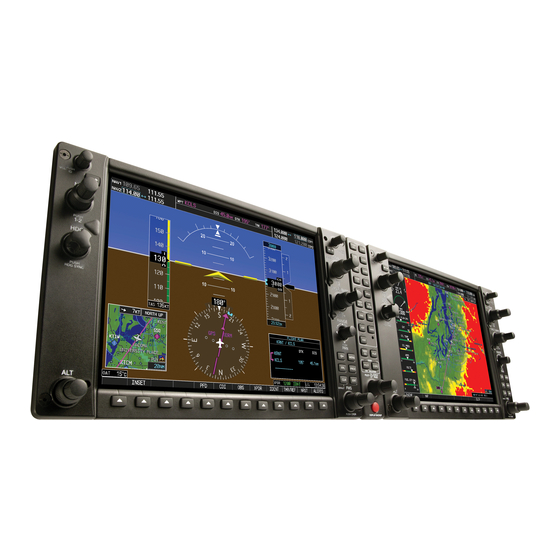GIA 63
The GIA 63 units serve as the main interface hub for the individual components of the G1000 system. All key components, such as
the GRS 77 AHRS, GDC 74A ADC, GTX 33 Mode-S transponder and GEA 71 Engine/Airframe Interface, provide inputs to both GIA 63
units. This allows for a higher level of system redundancy and integrity as data is cross-checked to ensure proper system operation.
The only component that is not connected directly to the GIA 63 units is the GMU 44 magnetometer; the latter interfaces directly with
the GRS 77 AHRS to provide it with magnetic heading input. The GIA 63 units also contain the communication and navigation radios
that include the VOR/LOC/GS and GPS receivers.
Failure Mode(s)
If a GIA 63 unit fails, the associated COM/NAV/GPS receiver data is no longer available and is automatically replaced by the COM/
NAV/GPS receiver data from the other GIA 63 unit. The operative GPS receiver automatically takes over any active GPS navigation
(without any pilot input). A red "X" appears over the COM/NAV frequencies to indicate GIA 63 failure (see Figure 4) and an alert
annunciation appears to the right of the altitude/vertical speed tapes on the PFD. The remaining GIA 63 continues to provide all
interface and system integrity functions. If both GIA 63 units fail, the AHRS and ADC continue to provide data directly to the GDU
units, although no navigational or communication capabilities are available. Partial failures in the GIA 63 units (such as failure of the
COM component) are more likely to occur than full component failures since the COM/NAV/GPS and interface components are all
independent inside the GIA 63.
GDC 74A
The GDC 74A is the ADC for the system and receives the standard pitot and static system inputs as well as the outside air tempera-
ture (OAT) input. This allows the system to automatically perform most E6B calculations, such as that of density altitude and true
airspeed.
Failure Mode(s)
If the GDC 74A fails, the PFD presentations of the airspeed, altitude, vertical speed, OAT and true airspeed (TAS) display a red "X",
as shown in Figure 4. In this case, the pilot should refer to the standby altitude and airspeed indicators installed in the aircraft. Certain
obstructions of the pitot static system can be verified by cross-checking the associated PFD indications with the standby instruments.
These PFD indications should be consistent with the readings found in non-G1000-equipped aircraft (zero airspeed on takeoff, etc.).
If the OAT probe fails, a red "X" appears both on the TAS box and the OAT box, and E6B-type calculations should be completed manu-
ally. Pressure altitude reporting for the transponder is also lost. That is, the transponder can only work in Mode A and can no longer
provide the information necessary for operating in Class C and B airspace.
GRS 77
The GRS 77 AHRS provides attitude and turn-rate presentation on the PFD and is interfaced with the GMU 44 magnetometer. The
GMU 44 is a tri-axial magnetometer which allows the system to measure both the horizontal and vertical components of the earth' s
magnetic field. Both the GRS 77 and GMU 44 are solid-state components that require very little initialization time (less than one
minute) and that can initialize while moving during taxi and in flight at bank angles of up to 20 degrees. The GRS 77 AHRS can still
operate in the absence of other reference inputs such as those from the GPS receiver, ADC, or magnetometer.
Failure Mode(s)
If the system detects that the GRS 77 is not operating properly when compared to other aircraft sensors, such as the GPS receiver,
ADC, or magnetometer, all attitude presentations are removed from the PFD and are replaced with a large, red "X" and the words "At-
titude Fail" (see Figure 4). Failure indications are designed to be displayed before any hazardous or misleading information (HMI) is
presented to the pilot. This represents a significant improvement over conventional mechanical gyro systems. If the GMU 44 fails,
only the stabilized heading data is lost.
4
G1000 SYSTEM COMPONENTS
Garmin G1000 Guide for Designated Pilot Examiners & Certified Flight Instructors
190-00368-02 Rev. A

